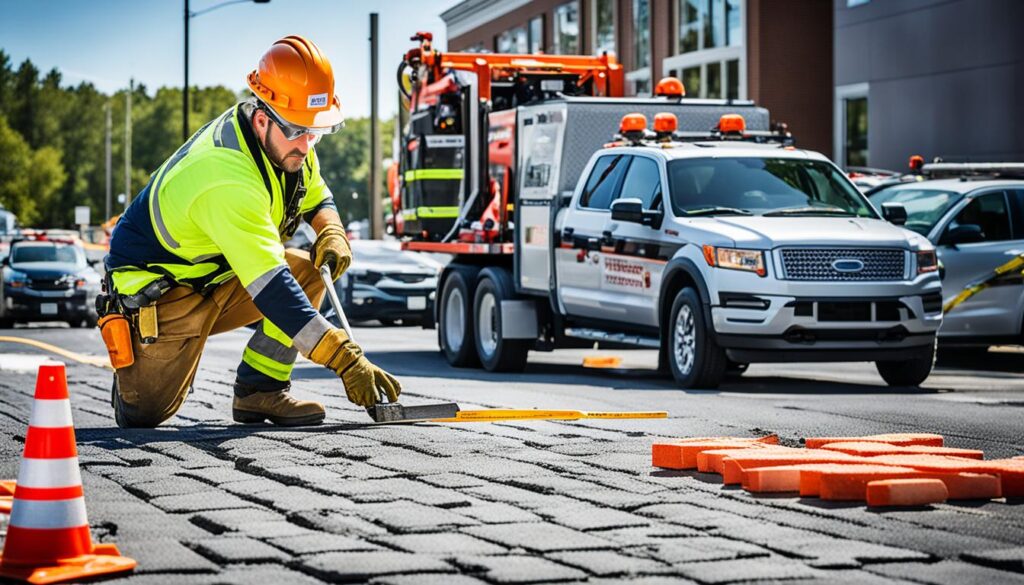
Starting a paver project in Prescott, AZ combines art with technical skills. Whether you’re making a calm outdoor area or a strong driveway is important. Safety is key when using tools. By following the right standards and practices, we can avoid risks. This ensures our projects are as safe as they are beautiful.
This guide offers useful tips for homeowners and pros on safe equipment use. You’ll learn about choosing the right tools and techniques to protect your hardscape projects in Prescott, AZ. Let’s work on creating something with excellent skill and safety.
Key Takeaways
- Recognize the necessity of equipment safety for any paver installation project.
- Learn how to handle tools properly to avoid accidents during stone paver installation.
- Gain insights into the significance of professional installation to achieve optimal results.
- Obtain expert tips to lay out patio pavers effectively while upholding safety precautions.
- Explore how foreseeing potential hazards can result in a seamless outdoor living space creation.
- Understand the role of proper equipment and practices when installing driveway pavers.

Understanding Paver Installation Equipment and Its Uses
Choosing the right paver installation equipment is crucial for a successful project. Whether it’s for a complex patio or a simple walkway, the right tools can greatly affect the result. This choice impacts both efficiency and the final look of your project.
Types of Tools Commonly Used in Paver Projects
Various tools are used in paver projects, each important in its way. For small adjustments and installations, manual tools like hammers, chisels, and hand tampers are essential. Electric tools, like concrete mixers, saws, and plate compactors, are key for larger projects. They ensure speed and accuracy.

Electric vs. Manual Paving Equipment: Pros and Cons
Electric and manual paver equipment offers different benefits and challenges. This overview of their pros and cons helps decide which is best for your needs.
| Equipment Type | Pros | Cons |
|---|---|---|
| Electric Paving Equipment | Time-efficient for large areas, less physical strain, precise cuts and finishes | Higher cost, requires electric power source, more complex maintenance |
| Manual Paving Equipment | More labor-intensive, slower for large-scale projects, may require more skill | More labor-intensive, slower for large scale projects, may require more skill |
The choice between electric and manual equipment usually depends on several factors. Factors like project size, budget, and skill availability are key. Electric tools fit industrial-sized projects better due to their efficiency. However, manual tools might be better for smaller, detailed work at home.
Preparatory Safety Measures for a Smooth Paving Process
Before laying the first paver, it’s vital to set up preparatory safety measures. These steps keep workers safe and make the paving process more efficient. It involves careful planning and a focus on workplace safety.

Start with a thorough site inspection. Make sure the area is clear of hazards. This step prevents accidents and delays. Next, organize your tools and equipment well. This helps avoid injuries and makes work go smoother. Good planning from the start ensures a safe and successful project.
- Assess the Terrain: Look for uneven ground and obstacles that could stop machinery or people.
- Gearing Up: Give workers the right safety gear for this tough job.
- Tool Preparation: Check that all machines are ready to use before starting.
- Communication: Make sure everyone can talk clearly and effectively with each other.
Using these safety precautions shows how important it is to plan for protection. Following these preparatory safety measures helps professionals do the paving process well. It keeps both the team and their work safe. This article deserves your attention – read it and be amazed
Paver Installation: Selecting and Operating the Right Tools
Starting a paver project is more than just having a vision. It’s about choosing and using the right tools effectively. Whether you’re working on a small garden path, a large driveway, or a cozy patio, knowing your tools is crucial. This knowledge helps you create a lasting and beautiful space safely and efficiently.
Step-by-Step Guide to Using Paving Equipment
Following a step-by-step guide ensures a smooth installation. The first step is selecting tools fit for your pavers. The selection ranges from simple hand tools for minor adjustments to power tools for big tasks. This will affect your work and efficiency.
- Determine your project’s scope and the different types of pavers you’ll use.
- Pick tools designed for paver installation, including both manual and powered types, based on your needs.
- Make sure you know how to operate tools safely and correctly, focusing on safety features and proper use.
- Use the manufacturer’s guidelines for setting up and using each tool, starting simple and getting more complex.
- Check your tools regularly for any wear or the need for adjustment, keeping them in perfect shape for continuing your project.
Adjusting Tools for Different Types of Pavers
Correct use of tools means adjusting them for different types of pavers. Whether it’s concrete, brick, or stone, each needs its settings and handling. Adjust your tools for the best performance.
- Look into the pavers’ properties, like thickness, material, and design pattern.
- Change the blade depth on cutters to suit the thickness of the pavers.
- Set the pressure and impact of power equipment based on the paver material’s hardness.
- Replace parts like drill bits or chisels to meet the specific needs of the paver type.
By following these steps and advice, you’re on your way to a successful paver installation. Knowing how to select the right tools, operate them confidently, and adjust as needed will make your project strong and beautiful. It will ensure your landscape lasts for years to come.
Implementing Safety Protocols for Equipment Operation
The safety of workers is key during paver installation equipment operation. Following strong safety protocols protects individuals and keeps the project on track. By combining quality equipment use with strict safety measures, we ensure a smooth paver installation. This approach reduces accident and malfunction risks.
Personal Protective Equipment (PPE) Essentials
Wearing Personal Protective Equipment is crucial for worker safety. Here’s a list of must-have PPE for equipment operation:
- Hard hats to protect against falling objects and accidental head contact with equipment
- Safety glasses or face shields for eye protection from debris and dust
- Ear protection to mitigate the risk of hearing damage caused by noisy machinery
- Steel-toed boots to protect feet from heavy paver blocks and machinery
- High-visibility vests ensure that workers are easily seen, reducing the risk of being struck by moving equipment
- Heavy-duty gloves to protect hands from abrasions and cuts while handling pavers and tools
Emergency Procedures for Accidents and Malfunctions
Emergency plans must be well-known and regularly practiced. When accidents or machine issues happen, acting fast can prevent further harm. Here are the steps to follow:
- Immediately stop using the equipment to avoid making things worse
- Alert nearby workers through known signals or devices
- Give first aid if needed, keeping the safety of injured personnel in mind
- Check the equipment problem; do repairs if you can, or call for expert help with tough malfunctions
- Report the incident following company rules to make sure it’s properly recorded and looked into
| Incident Type | Immediate Action | Follow-Up |
|---|---|---|
| Minor Injuries (e.g. cuts, abrasions) | Administer first aid; monitor the injured worker | Complete an incident report; review PPE and equipment |
| Major Injuries (e.g. fractures, head trauma) | Call emergency services; secure area | Isolate the equipment; mark it as out-of-service |
| Equipment Failure | Review safety protocols with the team; reinforcement training | Inspect and repair the equipment; retrain personnel if needed |
| Breach of Safety Protocol | Stop work; address the breach immediately | Review safety protocols with team; reinforcement training |
Safety protocols are about more than just following rules. They create a culture of safety in equipment operation. By always improving training and enforcing PPE and emergency rules, we lower risks in paver installation. This keeps everyone at the job site safe and ready for any problems.
Maintaining Tools for Longevity and Secure Operations
A craftsman’s skill shines with well-kept tools. Keeping your tools in top shape is crucial. It isn’t just about making them last longer; it’s about secure operations too. By taking care of your tools, you avoid accidents and ensure perfect results in your work. Good maintenance is key to both the durability of your tools and their best performance.
Starting equipment maintenance is about regular checks and clear steps. Just cleaning off debris, checking for wear, and proper storage can greatly help. Regular lubrication fights against rust and keeps things working smoothly. Being proactive in tool care means reliability. A well-looked-after tool won’t let you down.
Looking after your tools is more than just maintenance. It’s investing in your safety and skill. Setting up a maintenance schedule means every job meets high standards. These practices boost tool longevity and set a quality standard for your work. Commit to extraordinary tool care, and your work will show that same commitment and detail.
At Yavapai Landscaping, we provide expert snow removal services in Prescott, Arizona. Our team is dedicated to delivering efficient snow plowing, blowing, and shoveling to safeguard properties against winter hazards. We’re available 24/7, including holidays, ensuring safety and accessibility for our clients. We tailor our services to each property’s specific needs and utilize professional equipment for top-notch results. Our focus is on both residential and commercial clients, prioritizing their satisfaction and safety in all our snow removal tasks.
